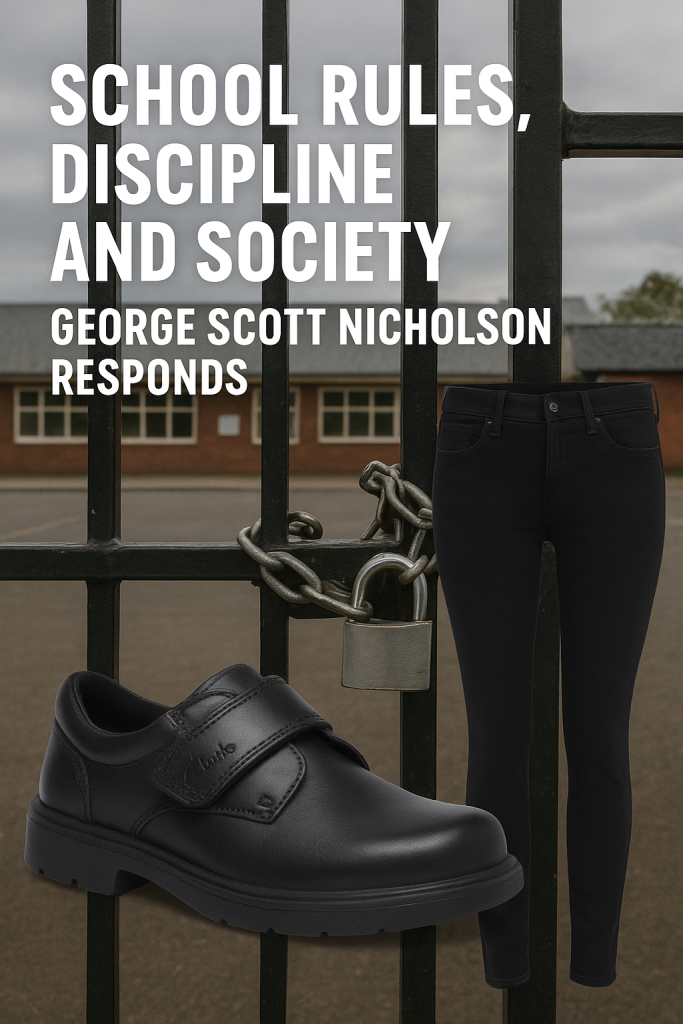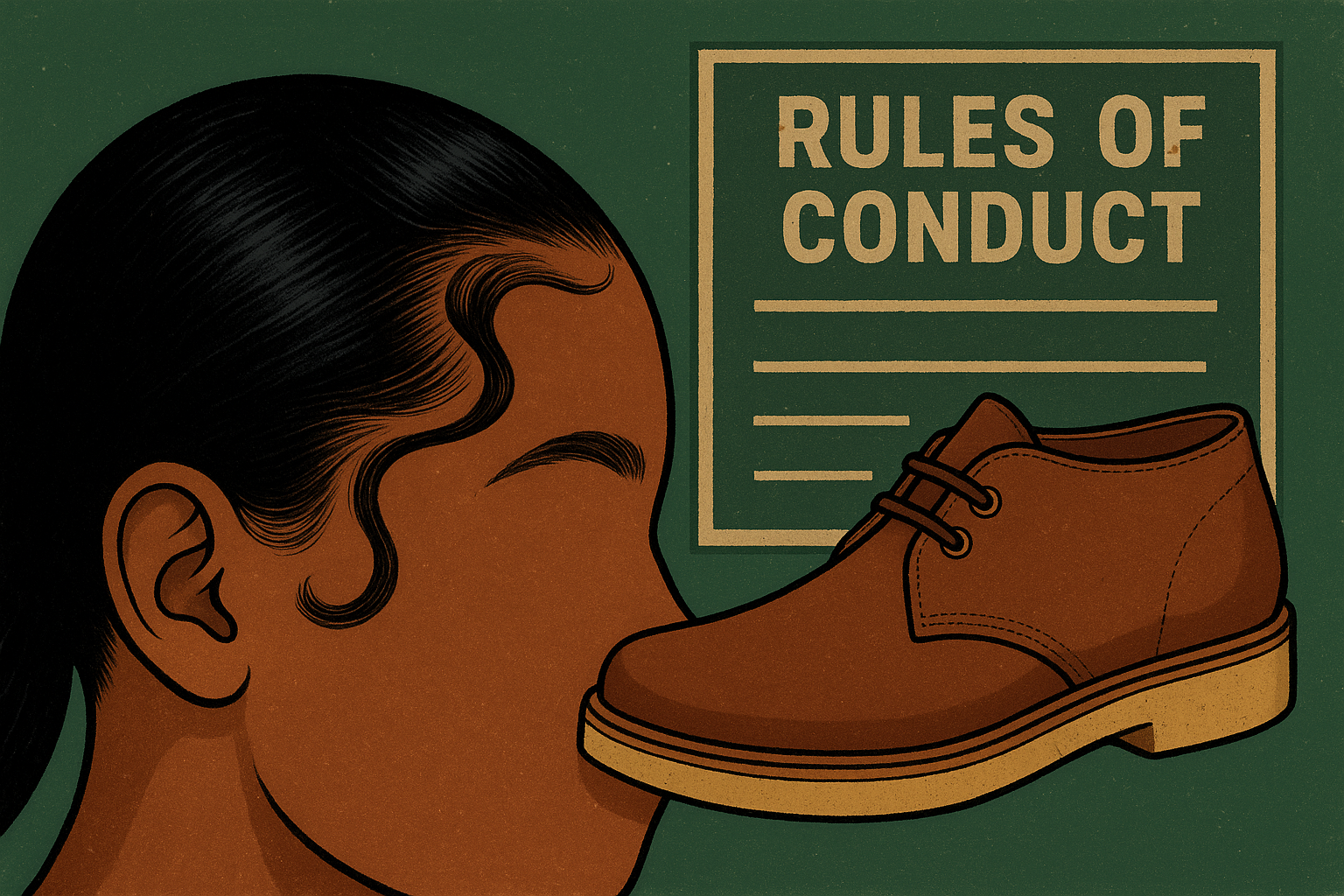Editor’s Note
The debate on school rules is heating up on social media. Coleen Douglas’ recent thinkpiece “Edges, Clarks, Rules and Student Success”—our first ever contributed story—struck a chord, sparking conversations about culture, discipline, and policy in Jamaican schools. One of our new readers, George Scott Nicholson, felt compelled to respond, offering another sharp and powerful angle to the discussion.
We invite you to read both sides, share your thoughts in the comments, and join the wider conversation about what school rules really mean in and for Jamaica today.
Recently, social media has been aflame, as it often is at the start of every academic year, with stories about students being locked out of school for “trite infractions” of “draconian rules” imposed by seemingly “tyrannical” administrators. The new flavour this year is “edges”… along with missing buttons, braids, and so forth. Naturally, these posts have sparked discussions on the policing of black hair and black bodies, anti-blackness, and colonial attitudes, along with vestiges of slave society.
Whatever happened to self-expression, some have asked. And what does learning have to do with hair? To the more nuanced eye, the narrative is often a knee-jerk reaction—self-righteous, pontificating, and lacking rigorous analysis. Some argue that these administrators benefitted from rules that were less draconian in the past and now, having assumed seats of power, wish to deprive others of freedoms they once enjoyed.
When I was at school an eon ago, facial hair among lower school boys was banned. Despite the clearly articulated rule, there I was nurturing the meagre strands that sparsely populated my chin—until the Dean of Discipline saw me. “You are aware of the rules,” she said. “Report to my office at 8:00 am tomorrow. You can shave it off, or I will.” I reluctantly shaved my beard and reported as required. The Dean showed me a rusty Bic razor she would have used (sans shaving cream) had I been in breach. Following her inspection, I was sent on my way.
Rules Mean Order, Not Oppression
The rule existed—we, the students, didn’t question why. Nor was it important to do so. The rule applied equally to all, regardless of race, ethnicity, social standing, or popularity. More importantly, the approach by the much-feared Dean was moderate and consistently applied. Her authority ensured the school operated within established rules, and she, too, was guided by them.

Other avenues for creativity existed within and outside school. Boys pierced their ears until the Dean stopped that, too. We staged a garbage bag and newspaper fashion show and participated in competitions like dropping eggs from the third floor into student-designed enclosures made of fudge sticks, toothpicks, and “[e]lastic.” We pushed against arbitrary rules, challenged authorities, and expressed ourselves in ways that did not undermine the system.
The point here is that there are rules. We can push to have them changed, and we can break them.
Some rules seem arbitrary but are designed to enforce discipline—this does not make them bad. Contrary to the current narrative, it doesn’t have anything to do with learning – that’s whataboutism. The rule about not having facial hair didn’t stifle my or anyone else’s creativity or impose upon our self-expression. The rule about edges (or braids) will similarly stifle no one.
Children and Teens Need Structure
The reality—for anyone who knows teenagers operating together in large numbers —is that we did bright, but we were almost feral and benefited from structure. Deans of Discipline and Studies often inflicted creative punishments, teaching us to break rules and face consequences with a sense of responsibility. I spent several detentions cutting grass with paper scissors, with unfinished sections to be completed the next day. The real issue is not the rule itself but rather the application of it.
—Is the authority’s action appropriate and measured, or is it an overreach by an overzealous administrator?
—Could enforcement cause harm or prevent a student from participating in school activities?
Conflating Social and Political Issues
Regarding parliament with ‘Anju’ and others in the JLP inna Clarks: We as a people need to understand (if we don’t already) that this is part of the show; adjoined to and part of the cut and thrust of parliament. Political gimmicks do not belong in discussions about school attire.

The Kareeba suit of the ‘70s, for instance, was once recognised by parliamentary rules as culturally appropriate. Yet, decades later, women still cannot enter some government spaces with uncovered shoulders.
Are Clarks Really That Innocent?
If we are doubtful about the impact of shoes, in this case, Clarks, on a school population or we think its impact is de minimis, we need look no further than Vybz Kartel and Popcaan’s 2010 hit of the same name and the response to it in the general marketplace.
If we are unsure about the need to police Clark’s, consider that boys are known to attend school with toothbrushes and other paraphernalia to maintain them; and many serious fights have broken out, both inside school and on the streets, due to stepping on someone’s “criss” shoes —with students even being hospitalised as a result. Is banning them, then, still ridiculous?

Many schools such as Immaculate Conception regulate shoes, socks, earrings, necklaces, hairstyles, etc., yet no social media uproar emerges.
School administrators, however, who lock children out because of a breach of rules, are simply too lazy to police their schools effectively. This is where our ire should lie.
No one at St. Andrew High School for Girls has a problem with “edges”. The students (and parents) have largely complied with the rule. The social media post was made by a student (on a student hub as a reminder to fellow students), while the statement about curtains remaining at home was merely a cute jab. Even their principal’s own bright pink hair aligns with the view that “edges” are not a major problem with their school administrators.
The Role of Schools in Society
The reality is, schools are not unchanging monoliths and must react to the problems of the day —whether the problem is hairstyles, fashion trends (we see you, tight pants), drugs, mode of dress, cell phones, or any other fad that arises.
Discipline, more specifically following rules, is about teaching students to make responsible decisions. Discipline demonstrates that there are consequences for their actions.
—George Scott Nicholson
The output of schools defines the society we must all live in.
Daily, we complain about the absence of a well-ordered society, yet we also lament school rules being enforced at a time when one is best able to learn how to follow them.
Regardless of whether they are under-resourced, have under-performing teachers and struggling children, or not, schools require structure and order to effectively operate.
Despite our shared past trauma, every flashpoint issue isn’t simply a result of the colonial past reflecting the need to police black bodies, an attempt to wantonly stifle expression, or rooted in anti-blackness. We shouldn’t treat them as such, but rather, look deeply …beyond that which is on the surface. Issues such as these understandably force parents, students, and administrators to balance discipline with culture, identity, and expression.
—George Scott Nicholson, former boundary testing student

About the Author
George Nicholson is a transport engineer and planner. A former teacher and lecturer at the University of Technology, he has advised national and regional governments on policy and led major infrastructure projects.
He enjoys witter banter, candid, stimulating conversations and exploring various creative endeavours.

